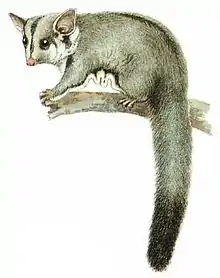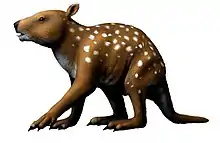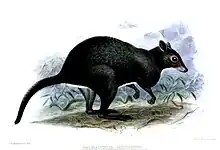| Nambaroo Temporal range: | |
|---|---|
| Scientific classification | |
| Domain: | Eukaryota |
| Kingdom: | Animalia |
| Phylum: | Chordata |
| Class: | Mammalia |
| Infraclass: | Marsupialia |
| Order: | Diprotodontia |
| Family: | †Balbaridae |
| Genus: | †Nambaroo Flannery and Rich, 1986[1] |
| Type species | |
| Nambaroo tarrinyeri Flannery & Rich, 1986 | |
| Species | |
| |
Nambaroo is an extinct genus of macropod marsupial from the late Oligocene to the early Miocene of Australia.[2]
Recent research suggests that the many species belonging to this genus may be either be invalid or belong to the closely related Ganawamaya.[3]
Sources
- ↑ Flannery, Tim; Rich, Thomas H. V. (1986). "Macropodoids from the Middle Miocene Namba Formation, South Australia, and the homology of some dental structures in kangaroos". Journal of Paleontology. 60 (2): 418–447. Bibcode:1986JPal...60..418F. doi:10.1017/S0022336000021958. S2CID 86029480.
- ↑ B.P. Kear; B.N. Cooke; M. Archer; T.F.Flannery (2007). Implications of a new species of the Oligo-Miocene kangaroo (Marsupialia: Macropodoidea) Nambaroo, from the Riversleigh World Heritage Area, Queensland, Australia, in Journal of Paleontology 81, pp. 1147-1167. (abstract)
- ↑ Butler, K. (2018). "Revision of Oligo-Miocene kangaroos, Ganawamaya and Nambaroo (Marsupialia: Macropodiformes, Balbaridae)". Palaeontologia Electronica. 21 (1): 1–58. doi:10.26879/747.
- "Granddaddy of Kangaroos" Found in Aussie Fossil at National Geographic
This article is issued from Wikipedia. The text is licensed under Creative Commons - Attribution - Sharealike. Additional terms may apply for the media files.



